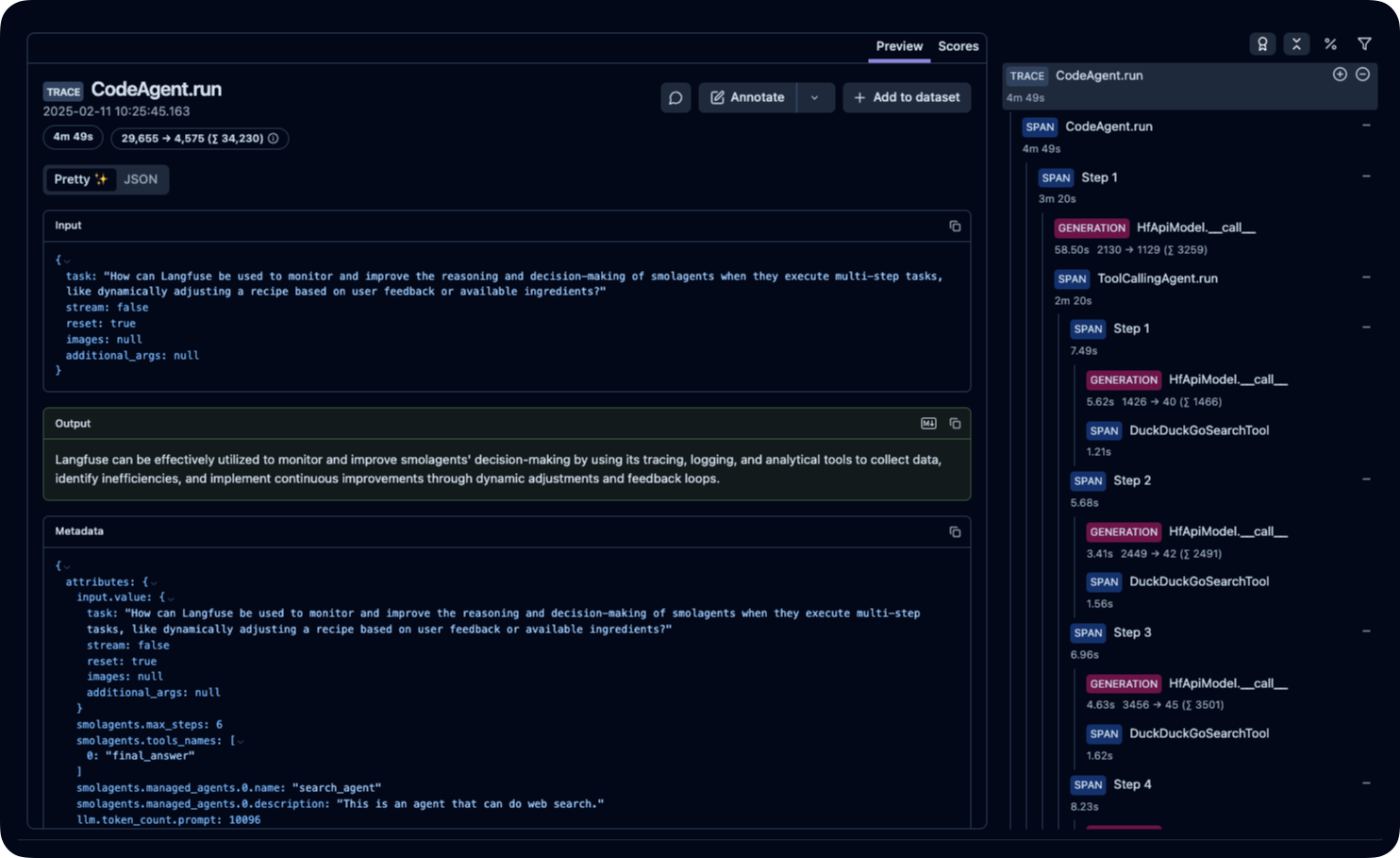Integrate Langfuse with smolagents
This notebook shows how to monitor and debug your Hugging Face smolagents with Langfuse using the SmolagentsInstrumentor. By the end of this guide, you will be able to trace your smolagents applications with Langfuse.
What are smolagents? smolagents is a minimalist and open-source AI agent framework developed by Hugging Face, designed to simplify the creation and deployment of powerful agents with just a few lines of code. It focuses on simplicity and efficiency, making it easy for developers to leverage LLMs for various applications.
What is Langfuse? Langfuse is an open-source platform for LLM engineering. It provides tracing and monitoring capabilities for AI agents, helping developers debug, analyze, and optimize their products. Langfuse integrates with various tools and frameworks via native integrations, OpenTelemetry, and SDKs.
Get Started
We’ll walk through a simple example of using smolagents and integrating it with Langfuse.
Step 1: Install Dependencies
%pip install langfuse 'smolagents[telemetry]' opentelemetry-sdk opentelemetry-exporter-otlp openinference-instrumentation-smolagentsStep 2: Set Up Environment Variables
Get your Langfuse API keys by signing up for Langfuse Cloud or self-hosting Langfuse.
Also, add your Hugging Face token (HF_TOKEN) as an environment variable.
import os
# Get keys for your project from the project settings page: https://cloud.langfuse.com
os.environ["LANGFUSE_PUBLIC_KEY"] = "pk-lf-..."
os.environ["LANGFUSE_SECRET_KEY"] = "sk-lf-..."
os.environ["LANGFUSE_HOST"] = "https://cloud.langfuse.com" # 🇪🇺 EU region
# os.environ["LANGFUSE_HOST"] = "https://us.cloud.langfuse.com" # 🇺🇸 US region
# your Hugging Face token
os.environ["HF_TOKEN"] = "hf_..."With the environment variables set, we can now initialize the Langfuse client. get_client() initializes the Langfuse client using the credentials provided in the environment variables.
from langfuse import get_client
langfuse = get_client()
# Verify connection
if langfuse.auth_check():
print("Langfuse client is authenticated and ready!")
else:
print("Authentication failed. Please check your credentials and host.")Langfuse client is authenticated and ready!
Step 3: Initialize the SmolagentsInstrumentor
Initialize the [SmolagentsInstrumentor](https://pypi.org/project/openinference-instrumentation-smolagents/) before your application code.
from openinference.instrumentation.smolagents import SmolagentsInstrumentor
SmolagentsInstrumentor().instrument()Step 4: Run your smolagent
This smolagent example has a manager CodeAgent that orchestrates the managed_agent, which can perform web searches to gather data. By using tools like DuckDuckGoSearchTool and VisitWebpageTool, it retrieves the U.S. 2024 growth rate and calculates how many years it will take for the GDP to double.
from smolagents import (
CodeAgent,
ToolCallingAgent,
DuckDuckGoSearchTool,
VisitWebpageTool,
HfApiModel,
)
model = HfApiModel(
model_id="deepseek-ai/DeepSeek-R1-Distill-Qwen-32B"
)
search_agent = ToolCallingAgent(
tools=[DuckDuckGoSearchTool(), VisitWebpageTool()],
model=model,
name="search_agent",
description="This is an agent that can do web search.",
)
manager_agent = CodeAgent(
tools=[],
model=model,
managed_agents=[search_agent],
)
manager_agent.run(
"How can Langfuse be used to monitor and improve the reasoning and decision-making of smolagents when they execute multi-step tasks, like dynamically adjusting a recipe based on user feedback or available ingredients?"
)Step 5: View Traces in Langfuse
After running the agent, you can view the traces generated by your smolagents application in Langfuse. You should see detailed steps of the LLM interactions, which can help you debug and optimize your AI agent.

Interoperability with the Python SDK
You can use this integration together with the Langfuse Python SDK to add additional attributes to the trace.
The @observe() decorator provides a convenient way to automatically wrap your instrumented code and add additional attributes to the trace.
from langfuse import observe, get_client
langfuse = get_client()
@observe()
def my_instrumented_function(input):
output = my_llm_call(input)
langfuse.update_current_trace(
input=input,
output=output,
user_id="user_123",
session_id="session_abc",
tags=["agent", "my-trace"],
metadata={"email": "[email protected]"},
version="1.0.0"
)
return outputLearn more about using the Decorator in the Python SDK docs.
Next Steps
Once you have instrumented your code, you can manage, evaluate and debug your application: